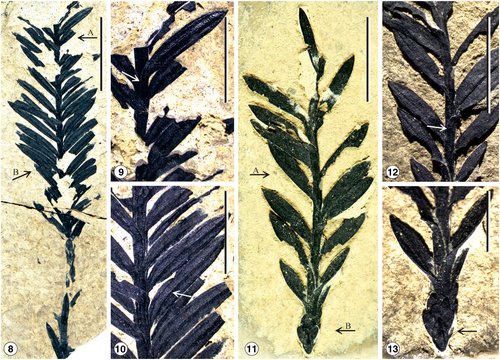
Sequoia sempervirens (D. Don) Endlicher, the coast redwood, is an evergreen conifer and the only relict species of the genus Sequoia Endlicher (Cupressaceae sensu lato). The paleogeographical origin of the relict North American Sequoia sempervirens is controversial. Study on the fossils of coast redwood is important to understand plant biogepgraphy and response of biodiversity to climate change.
Prof. ZHOU Zhekun and his team of Xishuangbanna Tropical Botanical Garden (XTBG) of Chinese Academy of Sciences found new fossil materials of Sequoia from Wenshan prefecture, the upper Miocene of Southeast Yunnan, Southwest China. These remains are represented by foliated shoots with linear and scale leaves, which have well-preserved cuticles. Additionally, one foliated shoot bearing a male cone at the apex was also found.
The specimens from Wenshan show that the proximal part of the leaf lamina is only slightly constricted and the adnate leaf base runs down the axis as a wide ridge. Moreover, the linear leaves are alternately arranged and leaf base is decurrent, lacking a petiol. Based on comparisons with related fossil and extant species of Sequoia, the researchers regarded the fossil as a new species and named it as S. maguanensis.
The researchers also explored biogeographic and paleoclimatic implications as well as the probable reasons for the disappearance of Sequoia from eastern Asia. They found that the principal foliage characteristics of S. sempervirens had already originated by the late Miocene. The presence of S. maguanensis in the upper Miocene of eastern Asia probably implies a Beringian biogeographic track of the ancestor of S. sempervirens in the early Neogene.
The finding of S. maguanensis in the upper Miocene of Southeast Yunnan, China, confirms the affinity of the Asian forms to the modern relict S. sempervirens. The present distribution of S. sempervirens is a relictual distribution with the extirpation of the Asian fossil representatives. Based on other floristic elements of the fossil assemblage in which it is found, the climatic context of the new fossil Sequoia in SE Yunnan is presumed to be warm and humid.
The study entitled “Sequoia maguanensis, a new Miocene relative of the coast redwood, Sequoia sempervirens, from China: Implications for paleogeography and paleoclimate” has been published on American Journal of Botany.

Figure: Sequoia maguanensis sp. nov. (Image by ZHANG Jianwei)

86-10-68597521 (day)
86-10-68597289 (night)

86-10-68511095 (day)
86-10-68512458 (night)

cas_en@cas.cn

52 Sanlihe Rd., Xicheng District,
Beijing, China (100864)

